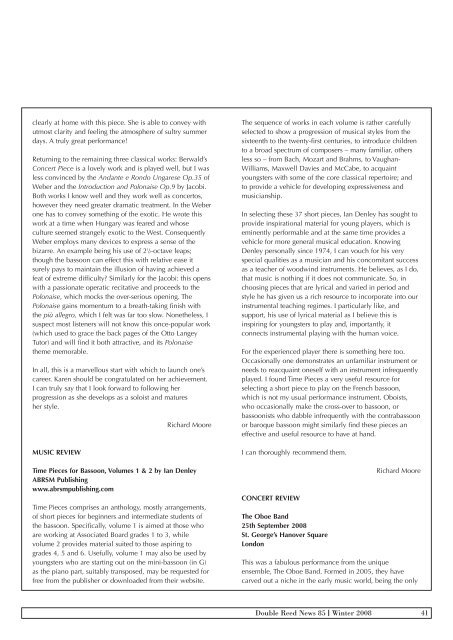Double Reed 70 cover - British Double Reed Society
Double Reed 70 cover - British Double Reed Society
Double Reed 70 cover - British Double Reed Society
Create successful ePaper yourself
Turn your PDF publications into a flip-book with our unique Google optimized e-Paper software.
clearly at home with this piece. She is able to convey with<br />
utmost clarity and feeling the atmosphere of sultry summer<br />
days. A truly great performance!<br />
Returning to the remaining three classical works: Berwald’s<br />
Concert Piece is a lovely work and is played well, but I was<br />
less convinced by the Andante e Rondo Ungarese Op.35 of<br />
Weber and the Introduction and Polonaise Op.9 by Jacobi.<br />
Both works I know well and they work well as concertos,<br />
however they need greater dramatic treatment. In the Weber<br />
one has to convey something of the exotic. He wrote this<br />
work at a time when Hungary was feared and whose<br />
culture seemed strangely exotic to the West. Consequently<br />
Weber employs many devices to express a sense of the<br />
bizarre. An example being his use of 2 1 ⁄2-octave leaps;<br />
though the bassoon can effect this with relative ease it<br />
surely pays to maintain the illusion of having achieved a<br />
feat of extreme difficulty? Similarly for the Jacobi: this opens<br />
with a passionate operatic recitative and proceeds to the<br />
Polonaise, which mocks the over-serious opening. The<br />
Polonaise gains momentum to a breath-taking finish with<br />
the più allegro, which I felt was far too slow. Nonetheless, I<br />
suspect most listeners will not know this once-popular work<br />
(which used to grace the back pages of the Otto Langey<br />
Tutor) and will find it both attractive, and its Polonaise<br />
theme memorable.<br />
In all, this is a marvellous start with which to launch one’s<br />
career. Karen should be congratulated on her achievement.<br />
I can truly say that I look forward to following her<br />
progression as she develops as a soloist and matures<br />
her style.<br />
MUSIC REVIEW<br />
Richard Moore<br />
Time Pieces for Bassoon, Volumes 1 & 2 by Ian Denley<br />
ABRSM Publishing<br />
www.abrsmpublishing.com<br />
Time Pieces comprises an anthology, mostly arrangements,<br />
of short pieces for beginners and intermediate students of<br />
the bassoon. Specifically, volume 1 is aimed at those who<br />
are working at Associated Board grades 1 to 3, while<br />
volume 2 provides material suited to those aspiring to<br />
grades 4, 5 and 6. Usefully, volume 1 may also be used by<br />
youngsters who are starting out on the mini-bassoon (in G)<br />
as the piano part, suitably transposed, may be requested for<br />
free from the publisher or downloaded from their website.<br />
The sequence of works in each volume is rather carefully<br />
selected to show a progression of musical styles from the<br />
sixteenth to the twenty-first centuries, to introduce children<br />
to a broad spectrum of composers – many familiar, others<br />
less so – from Bach, Mozart and Brahms, to Vaughan-<br />
Williams, Maxwell Davies and McCabe, to acquaint<br />
youngsters with some of the core classical repertoire; and<br />
to provide a vehicle for developing expressiveness and<br />
musicianship.<br />
In selecting these 37 short pieces, Ian Denley has sought to<br />
provide inspirational material for young players, which is<br />
eminently performable and at the same time provides a<br />
vehicle for more general musical education. Knowing<br />
Denley personally since 1974, I can vouch for his very<br />
special qualities as a musician and his concomitant success<br />
as a teacher of woodwind instruments. He believes, as I do,<br />
that music is nothing if it does not communicate. So, in<br />
choosing pieces that are lyrical and varied in period and<br />
style he has given us a rich resource to incorporate into our<br />
instrumental teaching regimes. I particularly like, and<br />
support, his use of lyrical material as I believe this is<br />
inspiring for youngsters to play and, importantly, it<br />
connects instrumental playing with the human voice.<br />
For the experienced player there is something here too.<br />
Occasionally one demonstrates an unfamiliar instrument or<br />
needs to reacquaint oneself with an instrument infrequently<br />
played. I found Time Pieces a very useful resource for<br />
selecting a short piece to play on the French bassoon,<br />
which is not my usual performance instrument. Oboists,<br />
who occasionally make the cross-over to bassoon, or<br />
bassoonists who dabble infrequently with the contrabassoon<br />
or baroque bassoon might similarly find these pieces an<br />
effective and useful resource to have at hand.<br />
I can thoroughly recommend them.<br />
CONCERT REVIEW<br />
The Oboe Band<br />
25th September 2008<br />
St. George’s Hanover Square<br />
London<br />
Richard Moore<br />
This was a fabulous performance from the unique<br />
ensemble, The Oboe Band. Formed in 2005, they have<br />
carved out a niche in the early music world, being the only<br />
<strong>Double</strong> <strong>Reed</strong> News 85 Winter 2008 41


